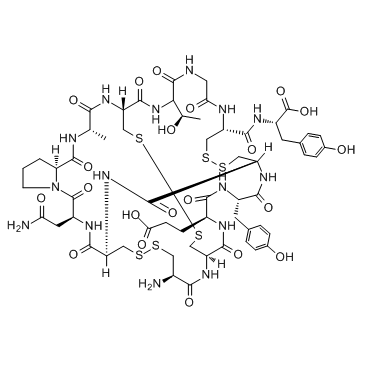Linaclotide
Modify Date: 2025-08-21 21:09:48

Linaclotide structure
|
Common Name | Linaclotide | ||
|---|---|---|---|---|
| CAS Number | 851199-59-2 | Molecular Weight | 1526.736 | |
| Density | 1.6±0.1 g/cm3 | Boiling Point | 2045.0±65.0 °C at 760 mmHg | |
| Molecular Formula | C59H79N15O21S6 | Melting Point | N/A | |
| MSDS | N/A | Flash Point | 1190.5±34.3 °C | |
Use of LinaclotideLinaclotide is a potent and selective guanylate cyclase C agonist; developed for the treatment of constipation-predominant irritable bowel syndrome (IBS-C) and chronic constipation. |
| Name | linaclotide |
|---|---|
| Synonym | More Synonyms |
| Description | Linaclotide is a potent and selective guanylate cyclase C agonist; developed for the treatment of constipation-predominant irritable bowel syndrome (IBS-C) and chronic constipation. |
|---|---|
| Related Catalog | |
| In Vitro | Linaclotide inhibits in vitro [125I]-STa binding to intestinal mucosal membranes from wt mice in a concentration-dependent manner. In contrast, [125I]-STa binding to these membranes from GC-C null mice is significantly decreased. After incubation in vitro in jejunal fluid for 30 min, linaclotide is completely degraded[1]. Linaclotide acts on guanylate cyclase-C receptors on the luminal membrane to increase chloride and bicarbonate secretions into the intestine and inhibit the absorption of sodium ions, thus increasing the secretion of water into the lumen and improving defecation; the drug is minimally absorbed into the systemic circulation[2]. |
| In Vivo | Pharmacokinetic analysis shows very low oral bioavailability (0.10%). In intestinal secretion and transit models, linaclotide exhibits significant pharmacological effects in wt, but not in GC-C null mice: induction of increased fluid secretion into surgically ligated jejunal loops is accompanied by the secretion of elevated levels of cyclic guanosine-3',5-monophosphate and accelerated gastrointestinal transit[1]. Linaclotide significantly increases weekly spontaneous bowel movements and complete spontaneous bowel movements (CSBMs) while reducing abdominal pain in patients with chronic constipation[2]. |
| Animal Admin | Mice: To determine oral bioavailability, three groups (n=3) of female CD-1 mice receive linaclotide (8 mg/kg) intravenously (i.v.), while two groups (n=3) receive linaclotide (8 mg/kg) by gavage (p.o.). Blood is allowed to clot for 5 min, centrifuged at 13,000×g for 3 min, and the serum is collected and stored at −80 °C until sample preparation and analysis by LC-MS/MS[1]. |
| References |
| Density | 1.6±0.1 g/cm3 |
|---|---|
| Boiling Point | 2045.0±65.0 °C at 760 mmHg |
| Molecular Formula | C59H79N15O21S6 |
| Molecular Weight | 1526.736 |
| Flash Point | 1190.5±34.3 °C |
| Exact Mass | 1525.389893 |
| PSA | 725.71000 |
| LogP | -5.84 |
| Vapour Pressure | 0.0±0.3 mmHg at 25°C |
| Index of Refraction | 1.712 |
| InChIKey | KXGCNMMJRFDFNR-IURAOCFRSA-N |
| SMILES | CC1NC(=O)C2CCCN2C(=O)C(CC(N)=O)NC(=O)C2CSSCC(N)C(=O)NC3CSSCC(NC1=O)C(=O)NC(C(C)O)C(=O)NCC(=O)NC(C(=O)NC(Cc1ccc(O)cc1)C(=O)O)CSSCC(NC(=O)C(Cc1ccc(O)cc1)NC(=O)C(CCC(=O)O)NC3=O)C(=O)N2 |
| Linzess |
| Linaelotide Acetate |
| L-Tyrosine, L-cysteinyl-L-cysteinyl-L-α-glutamyl-L-tyrosyl-L-cysteinyl-L-cysteinyl-L-asparaginyl-L-prolyl-L-alanyl-L-cysteinyl-L-threonylglycyl-L-cysteinyl-, cyclic (1→6),(2→10),(5→13)-tris(disulfide) |
| L-cysteinyl-L-cysteinyl-L-α-glutamyl-L-tyrosyl-L-cysteinyl-L-cysteinyl-L-asparaginyl-L-prolyl-L-alanyl-L-cysteinyl-L-threonylglycyl-L-cysteinyl-L-tyrosine cyclic (1->6),(2->10),(5->13)-tris(disulfide) |
| Constella |
| Linaclotide |
| LINACLOTIDE ACETATE |
| Cys Cys Glu Tyr Cys Cys Asn Pro Ala Cys Thr Gly Cys Tyr (disulfide bridge: 1-6; 2-10; 5-13) |
| N-({(1R,4S,7S,13S,16R,21R,24R,27S,30S,33R,38R,44S)-21-Amino-13-(2-amino-2-oxoethyl)-27-(2-carboxyethyl)-30-(4-hydroxybenzyl)-44-[(1R)-1-hydroxyethyl]-4-methyl-3,6,12,15,22,25,28,31,40,43,46,51-dodecao ;xo-18,19,35,36,48,49-hexathia-2,5,11,14,23,26,29,32,39,42,45,52-dodecaazatetracyclo[22.22.4.2.0]dopentacont-38-yl}carbonyl)-L-tyrosine |

